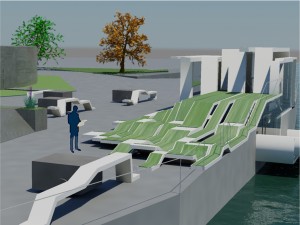Pour Me a House. Print Me a Cookie.

Print this!
When Elliot was in architecture school, he designed a chair in 3D software. Then he printed it. Then he sat in it. It held up pretty well.
As a designer, Elliot was an early adopter of 3D printing, also known as additive manufacturing. Elliot designs an object in 3D virtual space within a computer. (He’s an expert at this). The object exists as a set of mathematics, describing lines, arcs, curves, shapes, and so on.
Elliot then exports the mathematical description of the object to a 3D printer. The printer converts the math into hundreds of very thin layers – essentially 2D slices. The printer head zips back and forth, laying down a slice with each pass to build the product physically. It’s called “additive manufacturing” because the printer adds a new layer with each pass.
The earliest such printers might have been called “subtractive manufacturing.” You started with a big block of wax in the “printer”. You then loaded the mathematical description and the printer carved away the unnecessary wax using very precise cutting blades. The result was the object modeled in wax. You used the model to build a mold for manufacturing.
Elliot used a printer equipped with a laser and some very special powder. Based on the mathematical description of the slices, the laser moved back and forth, firing at appropriate points to build each layer. On each pass, the laser converted the powder into a very strong, very hard resin that adhered to the previous layer. At the end, Elliot had the finished product, not just a mold.
Elliot’s chair looked and felt like it was made of plastic. Several companies are now experimenting with metal oxides that use a similar process to print metal objects. A British company, Metalysys, is working with a titanium oxide that should allow you to print titanium objects. One benefit: it should dramatically reduce the cost of titanium parts and products.
Newer 3D printers can use a nozzle to extrude material onto each slice. What can you extrude? Well, cement, for instance. Construction companies in Europe are already using robotic arms and cement extruders to build complex walls and structures. It won’t be long before Elliot can design an entire house in virtual space and then have it poured on site. Elliot will be able to create much more imaginative designs (like the one above) and print them at a lower cost than traditional building techniques. What a great time to be an architect!
Not interested in cement? How about extruding some cookie dough instead? In fact, let’s imagine that you have some special dietary needs and restrictions. You submit your dietary data to the printer, which selects a mix of ingredients that meets your needs, and prints you a cookie. You can select ingredients based on your tastes as well as your dietary needs. What a great time to be a chef!
What’s next? GE recently announced that it would use additive manufacturing to create jet engine parts. Before long, we may be able to print new body parts. (I’m waiting for a new brain). And, 3D printing is coming to your home. Click here to find out how you can make anything. What a great time to be a nerd!